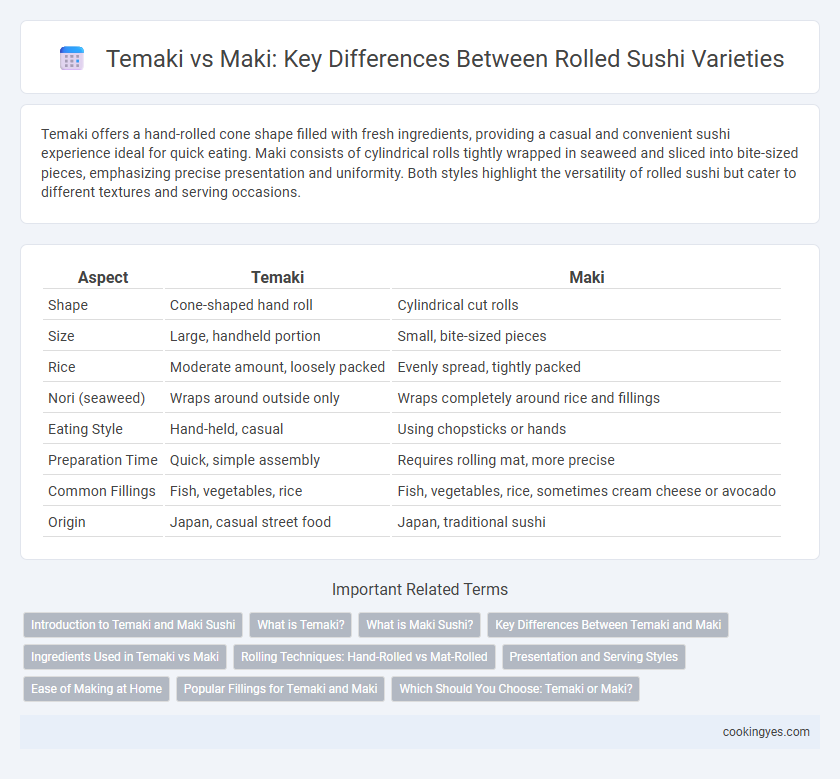Temaki offers a hand-rolled cone shape filled with fresh ingredients, providing a casual and convenient sushi experience ideal for quick eating. Maki consists of cylindrical rolls tightly wrapped in seaweed and sliced into bite-sized pieces, emphasizing precise presentation and uniformity. Both styles highlight the versatility of rolled sushi but cater to different textures and serving occasions.
Table of Comparison
| Aspect | Temaki | Maki |
|---|---|---|
| Shape | Cone-shaped hand roll | Cylindrical cut rolls |
| Size | Large, handheld portion | Small, bite-sized pieces |
| Rice | Moderate amount, loosely packed | Evenly spread, tightly packed |
| Nori (seaweed) | Wraps around outside only | Wraps completely around rice and fillings |
| Eating Style | Hand-held, casual | Using chopsticks or hands |
| Preparation Time | Quick, simple assembly | Requires rolling mat, more precise |
| Common Fillings | Fish, vegetables, rice | Fish, vegetables, rice, sometimes cream cheese or avocado |
| Origin | Japan, casual street food | Japan, traditional sushi |
Introduction to Temaki and Maki Sushi
Temaki and Maki represent two popular styles of rolled sushi, each with distinct characteristics. Temaki, known as hand-rolled sushi, is shaped like a cone and typically eaten with hands, offering a casual and customizable sushi experience. Maki, or rolled sushi, is tightly rolled with a bamboo mat, cut into bite-sized pieces, and traditionally eaten with chopsticks, emphasizing presentation and portion control.
What is Temaki?
Temaki is a cone-shaped rolled sushi characterized by its hand-held, open-ended structure filled with vinegared rice, fresh fish, vegetables, and seaweed (nori). Unlike traditional Maki rolls, Temaki is larger and easier to eat by hand, offering a casual and customizable dining experience. This style emphasizes fresh, high-quality ingredients wrapped in a crisp nori sheet, preserving texture and enhancing flavor.
What is Maki Sushi?
Maki sushi is a traditional Japanese rolled sushi consisting of vinegared rice, fish, vegetables, and other ingredients wrapped tightly in seaweed (nori) using a bamboo mat. The cylindrical roll is sliced into bite-sized pieces, offering a balanced combination of flavors and textures in each serving. Maki sushi varieties include hosomaki (thin rolls), futomaki (thick rolls), and uramaki (inside-out rolls), highlighting its versatility in Japanese cuisine.
Key Differences Between Temaki and Maki
Temaki and Maki are distinct types of rolled sushi, with Temaki featuring large, cone-shaped hand rolls wrapped in nori and filled with various ingredients for easy hand consumption. Maki, also known as makizushi, are cylindrical sushi rolls cut into bite-sized pieces, typically made using a bamboo mat to tightly roll sushi rice and fillings within a thin layer of nori. Temaki offers a casual, customizable eating experience, while Maki provides a more structured presentation ideal for plating and sharing.
Ingredients Used in Temaki vs Maki
Temaki sushi uses fresh, whole ingredients like fish, vegetables, and sushi rice wrapped in a large sheet of nori, allowing for a hand-rolled cone shape that highlights ingredient textures. Maki sushi typically features a tighter roll with vinegared rice, raw or cooked fish, cucumber, and avocado layered inside nori sheets and sliced into bite-sized pieces. The difference in ingredient presentation impacts texture and flavor intensity, with Temaki emphasizing individual component freshness and Maki offering a balanced, uniform taste in each slice.
Rolling Techniques: Hand-Rolled vs Mat-Rolled
Temaki sushi is hand-rolled, featuring a cone-shaped roll that allows for a looser, more textured filling, providing a casual and customizable eating experience. Maki sushi is mat-rolled using a bamboo sushi mat (makisu), ensuring a compact, uniform cylinder with tightly packed ingredients, ideal for precise slicing and presentation. The rolling technique significantly affects texture and appearance, with temaki emphasizing ease and individuality versus maki's structured form.
Presentation and Serving Styles
Temaki sushi features a cone-shaped roll that is hand-held and ideal for individual servings, showcasing vibrant ingredients in an open, visually appealing presentation. Maki sushi, in contrast, offers neatly sliced cylindrical rolls served on platters, emphasizing uniformity and ease of sharing in group settings. The distinct serving styles influence the overall dining experience, with Temaki providing a casual, interactive approach and Maki presenting a more structured, elegant display.
Ease of Making at Home
Temaki, or hand-rolled sushi, is generally easier to make at home due to its simple cone shape requiring no special tools and minimal technique. Maki sushi involves using a bamboo mat to tightly roll the rice and fillings into a perfect cylindrical shape, which can be more challenging for beginners. Home chefs often prefer temaki for its flexibility and quick assembly, making it ideal for casual sushi nights.
Popular Fillings for Temaki and Maki
Temaki and Maki sushi both feature popular fillings such as fresh tuna, salmon, avocado, cucumber, and crab meat, with Temaki often showcasing bolder combinations like spicy tuna and tempura shrimp for a hand-rolled experience. Maki rolls typically include classic fillings like eel with avocado, yellowtail with scallions, and pickled radish for balanced flavors wrapped in seaweed and rice. Both styles emphasize fresh, high-quality ingredients that highlight the umami and texture contrasts essential to Japanese rolled sushi.
Which Should You Choose: Temaki or Maki?
Temaki, known as hand rolls, offers a casual, cone-shaped sushi experience ideal for individual servings with fresh, easily customizable ingredients. Maki, traditional cylindrical rolls, provide a more structured presentation perfect for sharing and showcasing intricate fillings wrapped in seaweed and rice. Choosing between Temaki and Maki depends on whether you prefer a handheld, convenient bite or a classic, shareable sushi style.
Temaki vs Maki for rolled sushi Infographic

 cookingyes.com
cookingyes.com